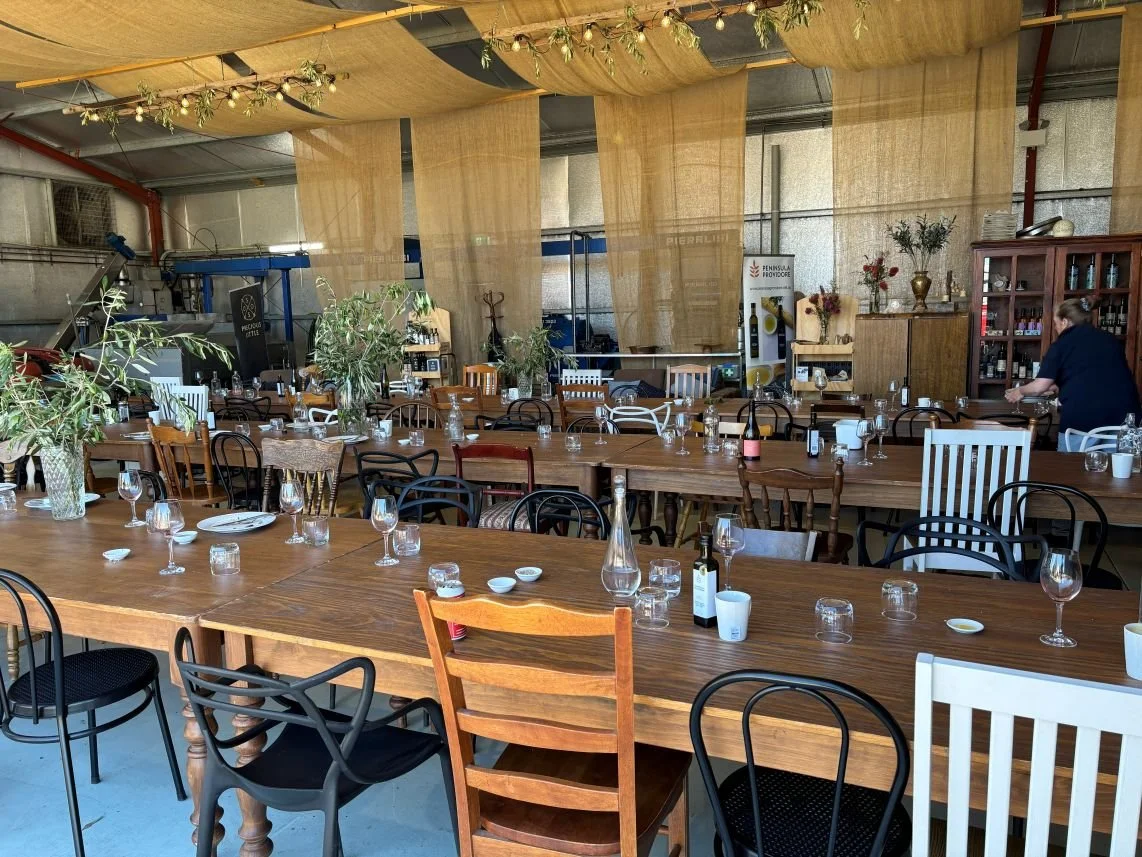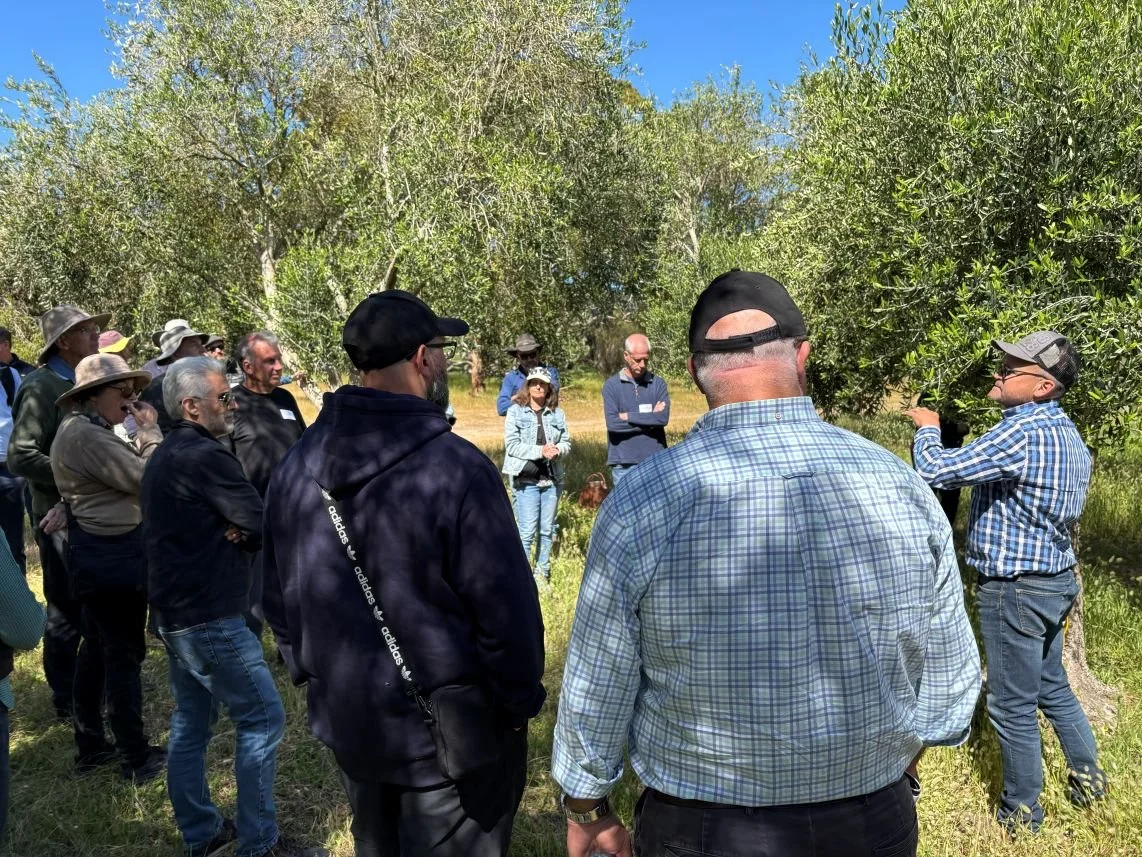Thoughts on the 2025 Australian Olive Association conference
Field trip. The visit to Oleapak. Emma and Ed described what they do and how they do it. Interesting to see the plant in operation and reasonably sophisticated (though not in the same league as the Modern Olives plant at Lara). Surprising that some of the most menial jobs (turning a flat packed box and placing over a dozen pre-assembled bottles) is still done by a person. I personally cannot imagine doing this all day every day.
Peninsula Providore also produced an excellent lunch!
Then on to Mel Hollick‘s place at Nangkita Olives / Peninsula Providore. One of the highlights was hearing Mel Hollick talk about her progress, what she had learned along the journey (both positive and negative) and what she would like to do / change. Typically lack of resources (like most of us - finances or time or both) made a number of items a ‘future project’. Mel was very transparent about what was working in her business and what needed further work. The really open and honest discussion was particularly helpful / illuminating.
Andrew Taylor explaining the finer points of rejuvenation pruning
The walk through the grove with Andrew Tayler and Robert Spooner-Hart along with Mel chipping in to explain what she did and why was a standout. The description of various diseases (specifically Anthracnose, Peacock Spot and Cercospor leaf mould along with an infestation of Olive Lace Bug in the previous season) and Mel’s approach was really informative. Furthermore, the demonstration of rejuvenation pruning with examples of prior years with subsequent regrowth is just not something that is easily learned by looking at YouTube videos! Also, although I have seen Andrew demonstrate ‘rejuvenation pruning’ in the past this is the first time that we could see the outcome 3,4,5 years down the track. To some extent it is really difficult to truly understand how it all comes together until you see this.
The exhibition space had lots of variety and it was great to catch up with some of the trade suppliers
Conference. Conferences take up a lot of time, cost and energy – so I always go into a conference hoping to get (at least) one or two key points that will make a significant difference to my farm business because taking 5 days (2 travel days, 1 field day, 2 conference days) is a big ask for a small business.
Not unexpectedly the two-day conference was a bit of a mixed bag given that it is trying to cater to people just coming into the industry (some of whom haven’t planted their first tree yet), others who have 20+ years of experience and some running businesses with in excess of 100,000 trees, others with less than 1,000 trees, and others who run peripheral businesses associated with the industry.
From my perspective there were some really outstanding presentations. Despite being scheduled at the end of a long day Claudia Guillaume’s presentation on EVOO quality was fantastic. A true tour-de-force - all in 45 minutes! A pity we ran out of time to ask more questions.
Prof. Arnon Dag’s presentation on optimizing macro nutrients was fascinating – in summary: - Nitrogen is really important but don’t over do it, Phosphorous is also very important – and more seems to be better, Potassium may not be as important as we have been led to believe! Interestingly he suggested that lack of Phosphorous may be a key driver of bi-annual bearing. Given that most Australian soils are low in Phosphorous this is particularly pertinent.
Not a key takeaway for me but really interesting to compare and contrast the research work being done in Israel and Australia’s NOVA site which had soooo much potential and then simply stopped because the funding stopped. Australia’s politicized research approach is just appalling for long term research.
As always, good to get an update on the olive industry biosecurity plan. There are quite a number of pests Australia is hoping to keep out and great to see that there is considerable focus on this (though whether it gets sufficient funding given the impact that they would have on the industry if introduced wasn’t really covered). Also, with the increasing focus on regenerative farming and dialing back the use of pesticides it was great to see Robert Spooner-Hart include some organic options in his Agri-chemical review.
And some brief updates on what’s happening in the consumer market by Andrew Burgess along with Jasmine Diamantaras’ update on what’s likely to happen to EVOO’s health star rating (don’t hold your breath!) as part of the current (delayed) review was helpful.
Table olives got plenty of focus with John Fielke explaining (not in much detail) the new process he is championing. Rather than using the traditional cold fermentation approach, or a caustic solution (typically lye) to ‘wash out’ the bitterness the method he is using adopts a lactic acid-brine bath that is continuously circulated via pump and filter system to remove the bitterness. I gather the filter system uses a resin filter (which is where the real IP sits). It takes at least as long as a cold fermentation – maybe longer (12 to 24 months) but the judges certainly liked the flavor. John indicated that it was really healthy approach – but given that fermented products have been shown to be very beneficial for the gut microbiome I believe it is probably premature to be suggesting that it is healthier than the traditional approach. The jury will probably be out on that for quite a few years.
I found the presenters really approachable to discuss particular queries I had and they went out of their way to help me as an individual grower. This is a fantastic opportunity and, in many respects, is much more valuable than the actual formal presentations.
The logistics for the field day and conference worked really well. A big shout out to Liz and Gerri (and no doubt others) who put in a huge amount of work to get it all to happen so smoothly. Well done to the AOA.


